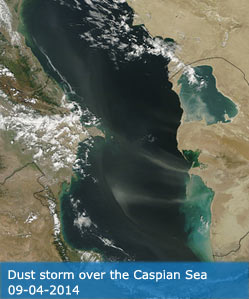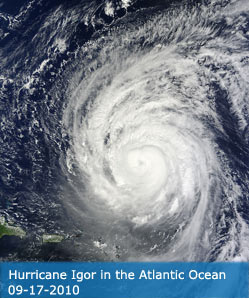Images
January 23, 2010 - Sea Ice and Clouds in the Bering Sea
Tweet
Sea ice and clouds create interesting textures in the Bering Sea in this image captured by the MODIS on the Terra satellite on January 16th, 2010. The sea ice is mainly in the upper right corner of the image where it creates tendrils near the waterline. Clouds sweep over the region in lines, called cloud streets. Cloud streets are cumulous clouds which result from rising columns of warmed air (thermals). If the thermal produces a consistent flow of warm air, and steady wind carries that air away, lines of clouds can form along the direction of the wind. An irregular surface may provide the perfect conditions for creating steady streams of warm
air interspersed with areas of cooler air. At the point where the clouds first form streets, they're very narrow and well-defined. But as they age, they lose their definition, and begin to spread out and rejoin each other into a larger cloud mass.
The Bering Sea lies between Alaska and the Aleutian Islands (to the east) and Russia's Siberia and Kamchatka Peninsula (to the west). The Bering Strait separates the Bering Sea from the Chukchi Sea which lies north above the Arctic Circle. The Bering Sea is itself not far below the Arctic Circle and sea ice that formed in November may last unil June.
Image Facts
Satellite:
Terra
Date Acquired: 01/16/2010
Resolutions:
1km ( B), 500m ( B), 250m ( B)
Bands Used: 1,4,3
Image Credit:
Jeff Schmaltz, MODIS Land Rapid Response Team, NASA GSFC
Tweet
Sea ice and clouds create interesting textures in the Bering Sea in this image captured by the MODIS on the Terra satellite on January 16th, 2010. The sea ice is mainly in the upper right corner of the image where it creates tendrils near the waterline. Clouds sweep over the region in lines, called cloud streets. Cloud streets are cumulous clouds which result from rising columns of warmed air (thermals). If the thermal produces a consistent flow of warm air, and steady wind carries that air away, lines of clouds can form along the direction of the wind. An irregular surface may provide the perfect conditions for creating steady streams of warm air interspersed with areas of cooler air. At the point where the clouds first form streets, they're very narrow and well-defined. But as they age, they lose their definition, and begin to spread out and rejoin each other into a larger cloud mass.
The Bering Sea lies between Alaska and the Aleutian Islands (to the east) and Russia's Siberia and Kamchatka Peninsula (to the west). The Bering Strait separates the Bering Sea from the Chukchi Sea which lies north above the Arctic Circle. The Bering Sea is itself not far below the Arctic Circle and sea ice that formed in November may last unil June.
Image Facts
Satellite:
Terra
Date Acquired: 01/16/2010
Resolutions:
1km ( B), 500m ( B), 250m ( B)
Bands Used: 1,4,3
Image Credit:
Jeff Schmaltz, MODIS Land Rapid Response Team, NASA GSFC




